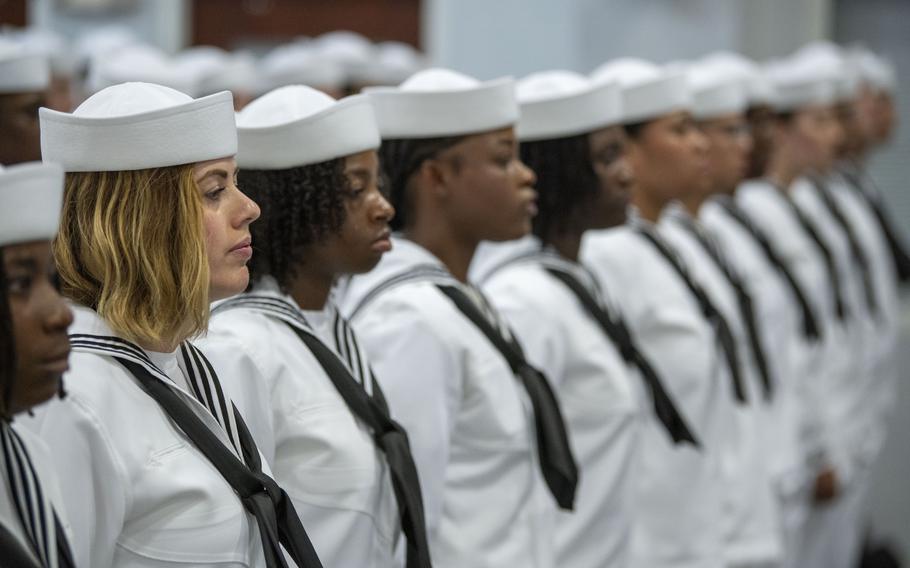
Graduating sailors during a Navy Recruit Training Command’s review at Great Lakes, Ill., on Jul. 25, 2024. More than 40,000 recruits train annually at the service’s only boot camp. (Christopher M. O’Grady/U.S. Navy)
Navy officials said Thursday that they are seeing significant results in recruiting after years of loosening requirements to combat missed enlistment goals, putting the service on track to boost its force by more than 40,000 sailors by the year’s end.
“I am very proud to announce the Navy has had its best stretch of recruiting results since 2020,” Rear Adm. James Waters, commander of Navy Recruiting Command, told reporters.
More than 36,700 individuals have joined the Navy since October 2023, with about 4,000 new recruits committing to the sea service each month. The Navy is on schedule to meet its goal of 40,600 recruits for fiscal 2024, though the service won’t be able to put them all through bootcamp before the fiscal year ends Sept. 30.
“I have got one bootcamp,” said Rear Adm. Jeffrey Czerewko, commander of Naval Education and Training Command in Pensacola, Fla.
The service set its recruiting goal of active-duty sailors for fiscal 2024 to attempt to make up for shortfalls of years prior. In 2022 and 2023, the Navy only contracted 22,000 and 30,000 sailors, respectively. Those same years, the Navy also emptied its delayed-entry pool, a program that allows people to sign up for the armed forces up to one year before they start basic training.
“But the real ‘what’ behind the bend in the curve for Navy recruiting is multifaceted,” Waters said.
Waters ticked off several factors that he said contributed to the recruiting surge, such as making it easier to join the Navy, focusing on meeting recruiter needs, and removing barriers or friction that hindered enlistment efforts.
The Navy felt pressured to loosen requirements, including accepting recruits with lower test scores and bringing in recruits who didn’t have high school diplomas or a GED diploma or certificate. The loosened requirements allowed the service to accept up to 20% of prospective sailors who receive a category 4 score — the second-lowest score level — on an entrance test that measures cognitive ability. The military has traditionally accepted very low numbers of category 4 scorers, and candidates with category 5 scores are ineligible to serve.
Vice Adm. Rick Cheeseman told The Associated Press that roughly 17% of its recruits this year are category 4.
Many of those sailors, the rear admirals said, are then put through the Future Sailor Preparatory Course, modeled after one set up two years ago by the Army, which has been successful. The Navy began its program in April 2023 and so far about 2,900 recruits have taken the academic course and at least 1,850 have completed it.
“We are helping these human beings move on to the next level and showing them what the Navy has to offer them,” Czerewko said.
The Navy also has achieved almost 100% staffing of its recruiter billets, which Waters described as his No. 1 priority.
“Their job is to prospect, build trust-based relationships and close,” he said.
Much of those conversations focus on what the Navy experience could be like for individuals on a case-by-case basis, Waters said.
Another key component to meeting recruiting goals, the rear admirals said, has been reducing the time it takes to make medical waiver decisions. Medical waivers can be given to candidates who might not meet established physical qualifications but might be able to serve without posing a danger to themselves or the Navy’s mission. In 2021, the process could take about 23 days. Now, the service can approve or deny a medical waiver within three days.
“Friction is being removed from the system. The impact on the psychology of the organization, in my opinion, and the morale increase of being able to see the fruits of your labors, as [Waters] talked, within zero to three days instead of months, has energized that organization,” Czerewko said.
More than 1,100 new recruits will be put through boot camp each week through the fiscal year’s end.
“We are focused now on normalizing the behavior so that we are steady into [fiscal 2025] and can ship across the year at a more steady rate than what we saw in ‘24,” Waters said.